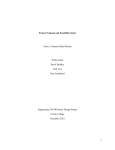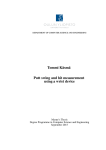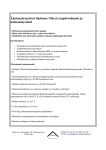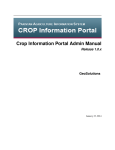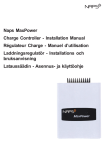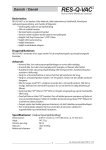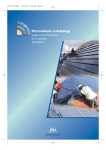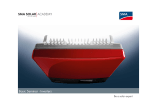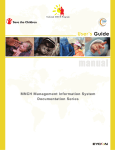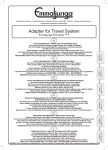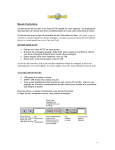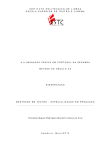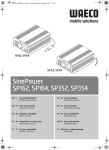Download securing electricity availability in a pakistani school
Transcript
SECURING ELECTRICITY AVAILABILITY IN A PAKISTANI SCHOOL Teemu Turunen Thesis April 2014 Degree Programme in Automation Engineering Technology, communication and transport 1 (61) DESCRIPTION Author(s) Turunen, Teemu Type of publication Bachelor´s Thesis Date 22.04.2014 Pages 61 Language English Permission for web publication ( X ) Title Securing electricity availability in a Pakistani school Degree Programme Automation Engineering Tutor(s) Puttonen, Pasi Assigned by Lamblamp® education refinement Abstract The object of this thesis was to solve the school’s problem in electricity availability, which was: the electricity grid in Pakistan was very unreliable. The problem was solved by designing and installing an electricity back‐up system. Besides, this thesis contains a plan for its maintenance. After making an estimation for electricity demand, different options to supply the need were com‐ pared and a hybrid system was selected, which combines both UPS and Solar photovoltaic system to provide electricity. The reason for this was that it was the most economical way to secure elec‐ tricity availability. It also had other advantages compared to other options. Because 100 % reliability was not necessary, achieving the best compromise between reliability and cost was the main pur‐ pose. Options to save electricity were also analyzed as well as reducing the demand for electricity and saving money and at the same time increasing the reliability of the system. As a result of this theoretical framework the size of the photovoltaic array, battery bank, charge controller and inverter needed were calculated. Additionally, connections between these compo‐ nents were designed, cable sizes were calculated and security equipment was designed according to the customer’s needs. There were problems finding all needed equipment, which is why minor changes to the plans had to be made. Finally the working system was made, despite these challeng‐ es. Together with all these electricity sources the system presented in this thesis is highly reliable to secure electricity and thus it can be said that the project result was successful and fulfilled the re‐ quirements set for the thesis. The hardest test will be the summer 2014, which will clearly test this system’s capability. Keywords Electricity production, Sustainable development, Photovoltaic, Renewable energies, Pakistan Miscellaneous 2 (61) KUVAILULEHTI Tekijä(t) Turunen, Teemu Julkaisun laji Opinnäytetyö Päivämäärä 22.04.2014 Sivumäärä 61 Julkaisun kieli Englanti Verkkojulkaisulupa myönnetty ( X ) Työn nimi Sähkön saannin varmistaminen pakistanilaisella koululla Koulutusohjelma Automaatio Työn ohjaaja(t) Puttonen, Pasi Toimeksiantaja(t) Lamblamp® education refinement Tiivistelmä Tämän opinnäytetyön tarkoitus oli ratkaista koulun sähkön saatavuudessa ollut ongelma, joka oli se, että Pakistanin sähköverkko oli erittäin epäluotettava. Se tehtiin suunnittelemalla ja asentamalla sähkön saatavuuden varmistava järjestelmä. Lisäksi tehtiin suunnitelma sen ylläpitoon. Sähkönkulutuksen arvioinnin jälkeen vertailtiin erilaisia vaihtoehtoja tarpeen täyttämiseksi ja pää‐ dyttiin aurinkosähkön ja UPS‐järjestelmän yhdistelmään. Syy tähän oli se, että se oli taloudellisesti järkevin tapa turvata sähkön saatavuus. Lisäksi sillä oli muita etuja vaihtoehtoihin verrattuna. Koska 100 % luotettavuus ei ollut välttämätöntä, tavoitteena oli paras kompromissi luotettavuuden ja hinnan välillä. Myös vaihtoehtoja energian säästämiseksi arvioitiin, koska siten voidaan vähentää sähköenergian tarvetta ja siten lisätä järjestelmän luotettavuutta ja säästää rahaa. Tämän teorian pohjalta laskettiin aurinkokennoston, akusto, lataussäädin ja vaihtosuuntaaja tarvit‐ tava koko. Lisäksi suunniteltiin kytkennät näiden komponenttien välille, laskettiin kaapelikoot ja suunniteltiin turvalaitteet asiakkaan tarpeiden mukaan. Tarvikkeiden hankinnassa tuli ongelmia, joten pieniä muutoksia suunnitelmiin piti tehdä, mutta lopulta saatiin toimiva kokonaisuus. Yhdessä kaikkien sähkölähteiden kanssa, tässä työssä esitetty järjestelmä on luotettava turvaamaan sähkönsaatavuus ja siksi voidaan sanoa, että projekti oli onnistunut ja täytti sille tässä työssä asete‐ tut vaatimukset. Suurin testi järjestelmälle tulee olemaan kesä 2014, joka tulee näyttämään mihin järjestelmä pystyy. Avainsanat (asiasanat) Sähköntuotanto, kestävä kehitys, aurinkosähkö, uusiutuvat energiat, Pakistan Muut tiedot 3 (61) Contents 1 2 Introduction ............................................................................................................ 4 Options to secure electricity supply ....................................................................... 8 2.1 UPS .................................................................................................................. 8 2.2 Diesel and gasoline generator .......................................................................... 9 2.3 Solar ................................................................................................................. 9 2.4 Wind .............................................................................................................. 12 2.5 Hydropower ................................................................................................... 13 2.6 Comparison between UPS, generator, solar, wind and hydro ....................... 14 3 Selection of electricity supply for the school ....................................................... 14 4 Fundamentals of solar energy .............................................................................. 16 5 Photovoltaic system.............................................................................................. 19 5.1 Introduction ................................................................................................... 19 5.2 Solar panels.................................................................................................... 21 5.3 Grid-connected system .................................................................................. 22 5.4 Stand alone system ........................................................................................ 24 5.4.1 Batteries .................................................................................................. 24 5.4.2 Charge controller .................................................................................... 26 5.4.3 Inverter ................................................................................................... 28 5.5 Combined electricity production ................................................................... 28 6 Saving electricity .................................................................................................. 29 7 Electricity demand and economic analysis .......................................................... 30 8 Design and parts selections .................................................................................. 33 8.1 Introduction ................................................................................................... 33 8.2 Solar array...................................................................................................... 34 8.3 Battery bank ................................................................................................... 34 8.4 Charge controller and inverter ....................................................................... 35 8.5 Electrical connections .................................................................................... 36 8.6 Cable sizing and breakers .............................................................................. 37 8.7 Mounting system ........................................................................................... 37 9 Plan for installation .............................................................................................. 38 9.1 Location ......................................................................................................... 38 9.2 Position .......................................................................................................... 38 9.3 Security and standards ................................................................................... 39 10 Buying equipment ................................................................................................ 39 11 Installation work ................................................................................................... 41 12 Plan for maintenance and operation ..................................................................... 45 13 Results and conclusion ......................................................................................... 45 REFERENCES ......................................................................................................... 48 APPENDICES .......................................................................................................... 49 Appendix 1: User's guide for operation and maintenance.................................... 50 Appendix 2: Direct and Latitude tilt solar map for summer ................................ 54 Appendix 3: Latitude tilt solar map for fall and winter........................................ 55 Appendix 4: Latitude tilt solar map for spring ..................................................... 56 Appendix 5: Table for Economical calculations .................................................. 57 Appendix 6: Table for Yearly average calculations ............................................. 58 Appendix 7: Table for summer calculations ........................................................ 59 Appendix 8: Table for winter calculations ........................................................... 60 Appendix 9: Table for spring and autumn calculations ....................................... 61 4 (61) 1 Introduction There is a school in Pakistan. They have used a grid to supply their electricity need, but because there is an energy crisis (the government of Pakistan calls it load shedding) in Pakistan, they need a solution for the problem (electricity comes and goes several times every day). Because the government is unable to solve the problem in near future, they have to do something by themselves. They had to make some kind of backup system against load shedding. In this thesis it is aimed to find an adequate solution for the problem by designing a proper system and then install it and make a plan for its maintenance. There are more than 180 million people living in the area of 796 000 km2 about same as Finland and Sweden together. Most of this area is desert and that is why population is concentrate to live near the Indus River and its branches. Pakistan is the second largest Muslim majority country in the world and the religion has a large effect on society and everyday life. Pakistan does not have large natural resources, most important being land for cultivation and half of the labor force works in agriculture. After that the most important is natural gas, which is much used for transportation and to produce electricity. There is also some coal which is not much used yet and of course Indus River with its braches has a huge potential for electricity production, which is just partially used so far. Labor force is cheap in Pakistan but instability of the county has reduced foreign investments in the past. The country is industrializing, but lack of infrastructure, especially current energy crisis slows down advancement. The country is facing other problems as well. Food and water security is big question now and in the future. Waste disposal is huge problem currently. Cities have open sewers and waste water goes directly to fields and rivers. 5 (61) Additionally dry waste end ups everywhere and recycling it is the job of poorest people. Not organized, but they try to make their living by looking something valuable. Also social issues exist. Level of education is low, only few people graduate from universities and many do not get any education at all (especially poor women). Salaries are low, but still country has some unemployment and much underemployment. That's why many people leave the country to seek better opportunities abroad. The government uses a great amount of money for military, mostly because it fears India so much. Military expenses are about 3.1% of GDP. That's a lot compared to education (2.4%) or health care (2.5%). For comparison, in Finland the same figures are 8.9% for health care, 6.8% for education and just 1.5% for military (CIA 2012). There is also relatively high inflation (nearly 10%), budget deficit and balance of trade is negative. When county faces challenges in basic services like food, water and energy it is hard to raise living standards of average people and additionally security is weak in many parts of the country. There are conflicts in Afghanistan border, Kashmir, Balochistan and security in old capital Karachi is also weak. If all these issues are put together it can be seen that Pakistan is struggling with huge challenges to give decent life for its citizens and without foreign investments and help it is difficult to get out of poverty and solve environmental issues. 6 (61) Energy situation in Pakistan now and in the near future According to IEA (International Energy Agency) Pakistan produced in 2011 sligtly less than half of its electricity by oil, major part of it imported, one third came from natural gas, hydro nearly 15% and others less than 10%. In other words, Pakistan relies much to fossil fuels to supply its electricity, hydro being only renewable resource. Pakistan's goal is to increase the use of renewable energies (other than hydro) to 5% by 2030. (Renewables in Pakistan 2012). It can be believed that Pakistan can reach much more than that, because prices for renewable energy have come down and most likely will continue to do so. Government just does not seem to be very interested, it can be guessed that mainly because high amount of capital is needed compared to fossil fuels and also lack of information because renewables have traditionally been more expensive way to produce electricity than fossil fuels. Figure 1: Share of fuels for electricity production (International Energy Agency 2011) 7 (61) Figure 2: History of electricity production (International Energy Agency 2011) If the development of electricity production is viewed in the past, it can be seen that after 2006 yearly production has stayed approximately same. At the same time population and economy has been growing, so demand for electricity is much bigger now. Power and water ministry of Pakistan have estimated that there is 4500-5500 MW gap between demand and production. That's why utility companies have exercised heavy load shedding to provide even some electricity for industry and households. Neighboring countries have offered to sell electricity to Pakistan, but so far the government has not approved the offers. Though there are rumors in Pakistan that the government has started to buy electricity from China. In summers situation gets worse, because then demand is highest. The author of the thesis had his own experience how electricity comes and goes randomly and it happens quite often even in winter when electricity is less used. The government has a plan to end load shedding by the year of 2017, but there is still at least 4 years left to suffer because of this problem. And if our government does not always keep its promises, it is not a surprise, if they are not able to solve the problem by 2017. The citizens are quite unhappy for the situation and rightly so, because it makes everyday life much more difficult. 8 (61) 2 Options to secure electricity supply 2.1 UPS There are several options to secure electricity supply. Most of them produce electricity and one is based on storing electricity. There is a brief introduction to them in this chapter. Just options for small scale production are presented. UPS (Uninterruptible Power Supply) is maybe the first option to consider if there are problems with energy supply. UPS is noiseless or almost noiseless and easy to operate, because it switches back-up on and off automatically when needed and ability to charge batteries. If the batteries are maintenance free this system is also maintenance free. If a grid fails just short periods of time this is a very good and economical solution to secure electricity availability. Problems start if the grid is off long periods. Then battery capacity has to be bigger and that raises costs. Most important and expensive part of UPS system is battery storage. To study more about batteries see battery section in chapter 5.3.1 (page 24). These systems are increasingly common in Pakistan and if considering all country this is not actually a solution to the problem. The reason for this is that UPSsystems actually increase electricity use from the grid; therefore if more people start to use these it leads to people without these being more time without electricity. 9 (61) 2.2 Diesel and gasoline generator If conventional energy is discussed, diesel or petrol generator is first option to produce electricity. It is a relatively low investment and not too difficult to maintain. Also, generators are easily available and it is possible to run one in almost everywhere. Biggest problem is price and availability of fuel. And in remote areas users might have to carry fuel for long distances. Additionally it is polluting and quite noisy and besides an engine needs some maintenance to keep its lifetime long and fuel cost low as possible. In Pakistan diesel generator is probably the most common solution for the electricity shortage. There are diesel or gasoline generators everywhere. This is not good for the economy because the price for electricity increases significantly and fuel is mostly imported, which worsens trade balance even more. 2.3 Solar UPS-systems or diesel generators are not the only possible options. There are alternative options; renewable energies are plenty available in Pakistan. Most obvious of them is the energy from the sun. There is plenty of sunshine all year around. Best places are in the center and south. Near the ocean there is less sunshine and in the north is the worst place in Pakistan for solar energy; however, compared to many other countries Pakistan has good resources of solar energy all over the country. The cost of solar panels has decreased during last 30 years and there is no reason for this trend to stop in near future. A few years ago industry set a goal to achive 1$/pW (peak Watt) production cost by 2013. In 2013 best manufacturers can get as low as 0.5$/pW. Solar panels cost about same everywhere, but installation costs vary much between different countries, but it possible to ob- 10 (61) tain less than 1$/pW for installed grid tie systems. This means that there are more and more economically profitable applications for solar systems. Economy is one issue, however, solar panels have other advantages as well. They are soundless, easy to install for many different places and in buildings they can be almost invisible. It does not need any fuel or maintenance (expect cleaning panel glasses at times in some locations). Disadvantages are high initial cost and total dependence on the sun. If sun is shining solar panels produce electricity and if not they produce nothing. Also early morning, evening or cloudy days they produce significantly less electricity, because production is directly related to insolation level. One of the best feature of solar panels is that they are very scalable. The system can be very small, for example just enough for charging a mobile phone and in the other end, 100MW or even bigger power plants can be built to produce a huge amount of energy. The cost per kW is not much higher for a small system than for a big one, which is very good news for small scale production. Figure 3: Solar map of Pakistan, yearly average, direct (Pakistan renewable energy society 2011) 11 (61) If solar maps for Pakistan are viewed, it can be seen that there are good insolation levels available all aver the country. So potential is huge for PV (Photovoltaic) and even CST (Concentrated Solat Thermal) as well. Jhelum (the city where the school is located) is marked with black circles. Seasonal solar maps are located in appendices two to four. Figure 4: Solar map of Pakistan, yearly average, tilted at Latitude (Pakistan renewable energy society 2011) 12 (61) 2.4 Wind Another option is wind energy. The cost of producing wind energy is falling as well as the cost for solar energy, which is mostly due to bigger and bigger mills. In some situations, if there is enough wind available, small scale wind production may be a good alternative to produce electricity. It can also be a good addition for solar energy, especially in places where solar radiation is not divided equally between seasons. For example in Germany, winter is the windiest season and naturally the sun shines least during winter. The windiest places are in the south near the coast, however there are also other good places for wind energy as can be seen if on the map below. Figure 5: Wind map of Pakistan (Pakistan renewable energy society 2011) 13 (61) 2.5 Hydropower There are many rivers in Pakistan and that is why there is plenty of hydropower available, especially in the north where the head is high and the flow rate is quite good. The government of Pakistan also support these kinds of activity and an Austrian company brings technology and knowledge for these systems (Renewables in Pakistan 2010). Output of a hydropower plant is a product of four different factors: the available flow, the head, the force of gravity and efficiency of the turbine. The force of gravity stays of course the same and most turbines are highly effective (5085%); therefore, most important factors are the available flow and the head. Available flow is discussed here because due to environmental reasons all river flow cannot go through the turbine. Mostly head but also flow determines which type of turbine is to be used. The most common turbine types are: Pelton, Francis and Kaplan. Pelton is suitable for high head and low flow rate sites, Kaplan for low head and high flow rate and Francis is suitable for uses between these. (Renewable energy a user's guide 2008). If small scale production is discussed, high head is economically more attractive, since it is cheaper to build to generate the same power. 14 (61) 2.6 Comparison between UPS, generator, solar, wind and hydro Now, if these options are considered there are some advantages and disadvantages when compared to each other. The following table illustrates the most important of them. Table 1: Comparison between UPS, generator, solar, wind and hydro Initial cost Operation cost Control of production Maintenance needed Noise Space needed Installation Environmetal effects UPS Moderate Moderate Generator Low High Solar High Very low Wind High Very low Hydro High Very low Moderate Good Bad Bad Good Low Moderate Low Low Low Very low Small High Small Very low Big Moderate Big Low Big Easy Moderate Easy High Moderate Low Difficult Low Difficult Low As can be seen, renewable options are expensive to build, but cheap to operate. Their most significant disadvantage is that their production is directly related to environment. If the sun is not shining, the wind blowing or water flowing in a river, there is no electricity. 3 Selection of electricity supply for the school The school is located in the city of Jhelum. It is located between Islamabad and Lahore and that is why it is quite far to the north, however, not at hillside. The school has currently 5 rooms in 2 floors. 3 are classrooms, 1 is an office and the last one is for residents. They are also expanding it to the 3rd floor and there will be 1 room more. There are more than 100 students and 6 teachers in the school. 15 (61) The school is Christian but there are some kids from Muslim families as well. Both boys and girls study in this school, which is very uncommon in Pakistan where schools are separate for boys and girls. They would like to have more students, but there is no space for that. The school started in 2008 with 8 students, so they have grown rapidly. In the beginning Finnish state also supported the school financially. There have been and still are many Finnish individuals and organization that support the school financially. Currently the school has a petrol generator to generate electricity during load shedding. Petrol is very expensive and the generator is too small to provide all needed electricity and, in addition, it is inefficient. Because of these reasons, normally when load-shedding exists they do not have any electricity; only when there is special need they start the generator. When solar, wind and regular map are considered, it can be seen that there is no wind or suitable rivers, but plenty solar energy available. . Latitude tilt fixed solar panels generate an annual average of more than 5kWh/day. That is quite evenly divided to different seasons, only winter is slightly weaker. Because summer is the season when electricity is most needed and the grid is not available this makes solar panels a very suitable way to produce electricity. Besides, electricity is more needed during the day than night and obviously PV produces electricity during the day, when the sun is shining. Photovoltaic module gives energy only when the sun is shining onto it. If it is cloudy energy the output drops to about from 1/3 to 1/10th from maximum and during the night there is no electricity at all. Because of these facts an energy reservoir is needed. If this situation is viewed from the economical point (more accurately see economic analysis in chapter 7 (page 30)) solar is the cheapest electricity life time expenses are considered, however, because storing electricity is quite expensive it is better to use grid when it is available. Combining solar and grid to- 16 (61) gether they provide cheapest electricity and then batteries are used only when either of these is not available, which also reduces both initial and life time expense of batteries, because smaller battery bank can thus be designed and it will be used in less deep cycles. This setting provides a very good compromise between reliability and cost (both initial and operation). Because it was decided to use solar energy it is good to understand more in detail and next chapter provides further information on it. 4 Fundamentals of solar energy Before practical applications for solar energy are discussed, in this case photovoltaic systems, it is good to gain some background information about solar energy. Solar energy from the sun comes to earth in radiation form. The energy of the photon can be calculated using following formula (Alternative Energy Systems and Applications 2010). Where h=6.625·10-34 J sec (Planck’s constant) and v the frequency. The frequency, wavelength (λ), and speed of light (c=3·108 m/s) are related as λ Combining these formulas the wavelength of light can be determined that corresponds to the band gap energy of silicon, 1.11 eV (Alternative Energy Systems and Applications 2010). 17 (61) λ 6.625 ∙ 10 34 ∙ Jsec ∙ 3 ∙ 108 ∙ 1.1183 ∙ 10 ∙ 1 1.11 ∙ 1.6 ∙ 10 J 1.12 This result has important implications for the operation and efficiency of photovoltaic devices. Photons with a wavelength greater than 1.12 μm contain insufficient energy to dislodge a valence electron in silicon; hence, photons with a wavelengths greater than 1.12 μm will induce no photovoltaic effect in silicon. Photons with a wavelength less than 1.12 μm possess more energy than is required to dislodge a valence electron, and the difference between the band gap energy and the photon energy is absorbed as heat by the PV device (Alternative Energy Systems and Applications 2010). The graphical representation in Figure 6 is useful to understand this. Figure 6: Photovoltaic effect (Alternative Energy Systems and Applications 2010) It can be seen that the shorter wavelength includes more energy, however, because in the visible spectrum radiation is the most intensive, which is the 18 (61) reason why it contains about half of all energy. That is why when energy from the sunshine is harvested materials with suitable band gap energy should be used. Solar irradiation reaches PV modules in three different ways: Direct, diffuse and albedo. The figure 7 below presents this. Normally direct radiation is the biggest portion, but in cloudy days diffuse radiation is the only one (because clouds block direct light). Figure 7: Routes for solar irradiation (Electricity from sunlight 2010) Additionally, it is important to understand the way of the sun during different times of day and season. This is important when energy is harvested from the sun, because the earth is moving around the sun and because the axis of the earth is not in same line with the sun, but inclined, which causes that north side of the earth takes the most sunshine during the summer and south side least and during the winter in the northern hemisphere just the opposite. The earth is rotating around its axis and this causes variation of day and night. 19 (61) Solar noon takes place in Jhelum is at 12:10. At that time the sun is at its highest point and also shines directly from south. With this information it is possible to turn solar panels directly to south, if a compass is not available. 5 Photovoltaic system 5.1 Introduction ”Photovoltaic” refers to the direct generation of electricity by solar irradiation (Alternative Energy Systems and Applications 2010). Often it is shortened to PV. Photovoltaic systems are divided into different sections based on the way how they are used. The main distinction is that some are grid tie and others are independent. There are also some special applications like water pumping. They all have some different component, however, there is at least one thing in common. They all harvest energy directly from the sun. And that is why PV systems have at least one common component and it is also the most important one: solar panel. There are of course many kinds of solar panels available; in this thesis the focus is on the one, currently most used: silicon based. Today’s PV modules are based on semiconductors. Electrically there are three main types of materials: conductors, insulators and semiconductors. Conductors have a free electron and that is why they conduct electricity well. The solids with covalent bond are insulators electrically (Science and technology of photovoltaic 2010). Between these there are semiconductors. These do not have a free electron at low temperature; however, they conduct some electricity at room temperature. Most important semiconductors are silicon and germanium (Science and technology of photovoltaic 2010). 20 (61) Generally silicon solar cell is a wafer of p-type silicon with a thin layer of ntype silicon applied to one side. N- and p-type silicon can be created by doping the silicon to produce the required variety and bringing them together creating p-n junctions. The first silicon must be purified to very pure and then some phosphorus is added to make n-type silicon, which has a surplus of free electrons. If some boron is added p-type silicon is gained, which has a deficit of free electrons (Renewable energy a user's guide 2008). If just pure silicon is used photovoltaic indeed takes place when light shines to it, however, electrons just randomly move in silicon and nothing useful is created. When a p-n junction is made it forces electrons to go other side (n-type). Then some conductive material can be added (for example silver) for both sides of a solar cell, these electrons can be conducted to an electrical circuit and their power can be used (Renewable energy a user's guide 2008). Bulk silicon is produced in long, cylindrical ingots and these are sliced into fine wafers. Once the wafers have been polished, doped and added with an anti-reflecting coating and electrical contacts applied, they are referred to as cells (Renewable energy a user's guide 2008). The majority of PV cells currently produced are Polycrystalline silicon. In the past monocrystalline dominated; however its share is coming down. Together these dominate the markets. Monocrystalline is more efficient especially in low light conditions, but it is more expensive to manufacture. Thin film is second generation technology and is made of other materials than silicon. It can be flexible, which is its main advantage, however, it is significantly more expensive compared to the same power silicon based systems and that is why it is less used, especially if the intension is to produce cheap electricity. 21 (61) 5.2 Solar panels Solar panels or modules are made of solar cells. Because a solar cell produces a relatively high current, but low voltage, they are connected in series to get more higher and useful voltage. Traditional solar panel, designed for 12V battery charging contains 36 cells, all connected in series. This gives about 21V open circuit voltage and 17V at maximum power point at standard testing conditions. Hotter operating temperature reduce both voltages; however, MPPV (Maximum power point voltage) still stays above 15V. This is enough for 12V battery what reaches about 14.5V when fully charged (Science & technology of photovoltaics 2010). Solar panel output is normally indicated in standard testing condition. It is 1000W/m2 at 25°C operation temperature. 1000W/m2 is a condition when the sun shines directly at noon from clear sky. Most of the time radiation level is lower than that. The current produced by solar panel is directly related to solar radiation. When radiation drops current also drops. Voltage also drops but just slightly. When the temperature changes the output of solar panel also changes. When temperature increases the voltage drops also. At the same time, the current increases, but only slightly so the power drops. To estimate a solar panel’s output during a day the term solar hour is used. It indicates how much solar power is available in a day or some other unit. For example near the equator typical amount is 5 solar hours. This does not mean that the sun shines just 5 hours/day, but that there are equivalent 5 hours at 1000W/m2. This helps to estimate solar panel’s output. For example, a 1kWp system gives about 5kWh/day in a location with 5 solar hours. In practice, a solar panel produces about 11 hours if where are 12 hours daylight, however, most of the production comes during noon from 10am to 2pm. Also, solar 22 (61) panel’s efficiency is not constant, but it normally drops when radiation is lower. Polycrystalline drops less than monocrystalline, however, the difference is not significant. If accurate values for production are to be calculated the operating temperature needs to be known. In history solar panels were mostly used for charging batteries; nowadays less than 5% of the panels go to these systems and the rest are used for grid connected systems, so that is why many panels use even a higher amount of cells in series and they produce higher voltages as well. When solar panels are connected in series or parallel or combination of these it is called an array. Because solar panels can produce just hundreds of Watts, in many cases it is necessary to use more panels and build these arrays. 5.3 Grid‐connected system As noticed in the previous chapter that grid connected systems dominate nowadays, it is useful to study them more detail. A grid-connected PV system contains only solar panels, a mounting system for them, an inverter, breakers (the inverter can has them internally) to connect and disconnect the panels to the inverter and an inverter to loads and cables to connect the panels to the inverter and the inverter to a grid (Principles of sustainable energy 2011). Interesting question is what happens to the grid-connected solar system when the grid shuts down? Because all grid-tie inverters have a safety function they will shut down when the grid shuts down and electricity cannot be produced even if the sun is shining. 23 (61) Inverter Inverters used for grid-connected systems have some requirements. They have to generate AC voltage which has same voltage and frequency than in the grid and the wave form also has to be same, so they have to be sinusoidal. Additionally, it has to be able to operate with variable DC voltage and current coming from solar panels. There are two types of methods in the markets to do that. One is selfcommuted, where the inverter's intrinsic electronics lock its output to the grid; and line-commuted, where the grid signal is sensed and used to achieve synchronization. There are four main types according to their mode of use as well (Electricity from sunlight 2010): Central. All electricity from solar panels comes to the main inverter and it converts it to AC and fed to the grid. String. Multi-String Individual. Every solar module has its own inverter and they feed it to the grid. Normally all grid-tie inverters are MPPT (maximum power point tracking) type. That allows taking as much electricity as possible out of panels and putting it to loads and the grid. Because inverters cannot generate exactly sinusoidal wave form, this causes some distortion. Normally this is indicated as total harmonic distortion which is often shortened to THD. 24 (61) 5.4 Stand alone system 5.4.1 Batteries Stand-alone systems are very different compared to grid-connected. Solar modules are the same or similar, however more components are needed. The most significant difference is that stand alone system cannot rely on any other energy source as a grid, but it has to produce and store all needed energy. As is generally known, photovoltaic module gives electricity only when sun is shining. Sometimes it is possible to connect a load directly, for example to a pump because then a tank can be used as a reservoir and the pump operates when sunlight is available, but in most cases electricity needs to be used even when the sun is not shining. That is why a storage system is needed. Most common are batteries, which are presented in this subsection. It is possible to use several kinds of batteries, however, the most common is lead-acid type, because they are the cheapest batteries for that purpose and their efficiency is relatively high compared to some other types. Also, these types of batteries have existed about 100 years in the market and during that it has been noticed that they are rugged and reliable. Flooded (wet) lead-acid batteries are familiar because every car has one. Batteries for cars have been designed to give a high current for a short period of time (engine start) and after that they will be charged to full again. For this reason they have thin plates and high surface (Science & technology of photovoltaics 2010). In PV systems the case is different. Normally the load is relatively low and occasionally the battery can be fully discharged, for example if it is cloudy many days. Because car batteries cannot handle several full discharges they will die too quickly and are not suitable for PV systems. Of course if you can get old car batteries are available for free they can be considered as an option, however, they have to be changed quite often. In most cases this is not an option thus car batteries have to be abandoned and another solution needs to be 25 (61) found. Fortunately, there are batteries designed for this purpose and they are called deep cycle batteries. They are designed to last several full discharges without a huge impact on their capacity. These batteries have thicker plates, which is why they are also heavier compared to same capacity car batteries. Always when a battery is used chemical reactions take places and causes that its plates are consumed little bit. That is why batteries with thicker plates last longer time. These lead-acid deep cycle batteries are divided into three different types, depending on what kind of electrolyte is used. The most common is standard flooded, followed by AGM (absorbed glass mat) and GEL type (Science & technology of photovoltaics 2010). The most common type of battery is flooded, because it gives the best price/performance/capacity ratio. Its weakest point is that it needs some maintenance and care when transported (Deep Cycle Battery FAG 2013). Gel batteries do not have liquid electrolyte, but silicon. An advantage about this material is that it is not spillable, even though a battery is broken. That is why it is easier to transport. Disadvantages are that it has to be charged more slowly than a liquid one; otherwise the battery will suffer permanent damage (gassing->electrolyte goes away and cannot be restored). The same happens if the battery is discharged with too high a current (Science & technology of photovoltaics 2010). AGM batteries have all advances that gel, however, none of its disadvantages. Only disadvantage is that when used at hot temperatures it suffers more than others. Also it is 1.5-2 times more expensive than flooded, but just slightly more than gel. That means that this battery is very suitable for PV systems. Not everyone needs these benefits and if adding water at times is not a problem for those flooded battery is the best because it is the most economical (Deep Cycle Battery FAG 2013). 26 (61) One important thing to look is battery's life time. Normally it is measured in cycles. One cycle means discharging 100% charged battery to 20% charge level and then charge it back to full again. This is a normal cycle, but manufacturers may give other depth of cycles as well or several different, for example Rocket battery datasheet has life time for 30%, 50% and 100% deep cycles (Rocket battery datasheet 2013). Life time mentioned in years for batteries is many times given with assumption of 10% or less deep daily cycles. For example there is a battery with 600 cycles at 80% and it is used daily like that it can be assumed that it lasts 600/365=1.6 years and with 10% discharge it may last 5000 cycles which means 5000/365=13.7 years, which is a huge difference with the same battery. Carefulness is required when some manufacturer promise for example 12 years life time and some other just 5 years. It has to be figured out ahat the assumptions behind these figures are (Deep Cycle Battery FAG 2013). 5.4.2 Charge controller The task of a charge controller is of course to charge a battery or a bank of batteries. As simple as it sounds, there are few important issues: how to charge the battery depends on its stage. When a battery is empty it can be charged with high current and when it is reaches its full charge, the charging current should be smaller. Finally, when the battery is full it is charged just slightly to keep it full. These steps are also called constant current stage, constant voltage state and float charging. The problem is to know the actual state of a battery. When a battery is not used for about an hour then the measured voltage indicates the real state of a battery. When a battery is used its voltage drops compared to the A heavier drop leads to a larger voltage drop. Also, after disconnecting the load the voltage remains lower and it takes some time to recover. When the battery is charged the same happens however oppositely. The more the battery is charged, the higher the voltage is in the battery. It also takes some time until the voltage drops to a real value after charging it. One issue more is that battery voltage is affected by temperature. For example, if battery voltage is 12.5V at 25°C it is at different state of charge than 12.5V at 15°C. 27 (61) That is why more sophisticated charge controllers has a temperature compensation as well (Electricity from sunlight 2010). There are different kinds of charge controllers and they need to be further explained before being able to choose an adequate one. The most traditional is the series charge controller. It is simple and cheap, so it has been much used especially in small systems. A switch to connect a source to a battery is in series, so that is why it is called series type. When it becomes nearly fully charged the current must be limited and it is done by cutting on and off the incoming power in high frequency using PWM (Pulse Width Modulation) method (Electricity from sunlight 2010). The other type is shunt. The difference compared to series type is that a switch is connected in parallel. This leads to short circuiting the panels when the switch is connected (Electricity from sunlight 2010). The disadvantage in both series and shunt type is that the panels are forced to operate at the same voltage than the battery or batteries. This leads to the fact that most of the time the solar panels are not operating at their maximum power point and they are not producing as much as they could. There is a solution to this problem and it is called MPPT (maximum power point tracking). This type of charger uses DC/DC transformer so that the solar panels can operate at different voltage than batteries. Also, there is MPP tracker which tracks what the maximum power point of the solar panels is. With this technology the most of the solar panel production can be taken into use. With this type there is also a switch using PWM to limit the current going to batteries when it is needed. Because this is more expensive than other types it is normally used in bigger systems, where higher production compensates the price of the charge controller. Nowadays it is also used under 1kWp systems (Electricity from sunlight 2010). 28 (61) 5.4.3 Inverter Solar panels produce DC and batteries store DC. So far everything is good, but because most equipment are designed for AC, thus an inverter is normally needed. There is some equipment for 12 VDC; however, because their amount and availability is limited, most stand-alone solar systems are AC. Inverters have developed much during the last decades. In the past inverters were expensive and their efficiency was weak and quality of AC electricity was low. Compared to grid-connected systems inverters have less requirements in stand-alone systems. The reason for this is that inverter uses batteries for energy source and that is why input voltage is relatively constant. Also, batteries can provide high currents if needed. On the other side, output voltage does not have to be matched to grid so voltage and frequency may vary. Normally inverters produces sinusoidal wave form, which is same than in grids, then all equipment can use it without problems. 5.5 Combined electricity production Combined electricity production is also known as hybrid systems. Many times it is expensive to design a solar system to produce all electricity because then the size of panels and battery bank must be big enough to cover even peak demand and/or low insolation times. If some additional power source can be used to give more electricity during peak demand the size of a battery bank and a solar array can be reduced as well as the initial cost of the system. This also sorters the payback time of the system. 29 (61) When combining different energy sources, it is to be considered how to connect these sources to loads. This is especially important when talking about grid-connected systems. If our own power supply is to be used at the same time as the grid, the system needs to be synchronized to the grid, otherwise there will be serious problems. If continuous electricity is wanted even when the grid goes off, this scenario places even higher requirements on the system. The system needs to be synchronized at first to the grid and when the grid is off, electricity should be produced independently ourselves and then when the grid comes back the system is to be synchronized again to its frequency. There is another option, if an inverter with grid connection option is not wanted to be used is the following: a small delay should be allowed when changing energy supply to other. Relays can do this so quickly that it is barely noticed, and computers and other electrical equipment are not turned off during the process. One option is also to supply some of the most important equipment with solar energy all the time. The rest take their electricity from the grid and when it is off then they are off. 6 Saving electricity Saving electricity may sound something negative; that it is to reduce the standard of living or similar. In some cases this is true. If electricity is not available, it is not used and then it is saved, however, the living conditions are weakened. Still, there are some other ways to reduce electricity use without any negative effect on normal life. First, a very obvious and the cheapest way is to shut down appliances if they are not needed. If there is no one in a room, it is totally unnecessary to keep lights or fans on. If no one is watching television why to keep it switched on? 30 (61) The list goes on, there are many possibilities to act. To put this into practice it is necessary to teach the users about these issues. Another way to save electricity is efficiency. Many equipment waste plenty of energy as heat just because their technology is old, or, also if insulation in a house is not good, the generated heat or coolness goes away. An advantage in energy saving is that generation can be decreased even more than what is actually saved (because in this case the distribution losses are also smaller). 7 Electricity demand and economic analysis First thing before designing a solar system or any other type of electricity production is to figure it how much energy and power is needed. To do that a list was made of all equipment in the house and estimation for how much they are used in average during different seasons. Then solar maps were looked to see how much the sun is available during different seasons. If good reliability is wanted production should match the consumption all the time. This is just average, but each day consumption and production varies so this needs to be taken into account as well. 31 (61) Table 2: Table for estimated electricity use, yearly average If high reliability is not as important as low cost then a good balance between these should be found. In customer’s case this was the thing, so a yearly average consumption and production was set as a starting point. The target was to produce 100% of the average demand for load shedding period. Then it was calculated how big a solar array was needed. This is explained in the chapter 8.1. on solar array. As can be seen from the table, the average daily electricity use is about 13kWh. Lightning being the biggest user (3.3kWh), then fridge (2.4kWh) and fans (2.2kWh). The fridge is very old and that why it uses much electricity. Ways to reduce this are looked into the energy saving section (chapter 6). 32 (61) Economic analysis Oil prices have gone up and because oil is limited resource and in long period demand grows more rapidly than supply and that's why it is expected that oil price continue to rise. And because Pakistan has very limited oil reserves it has to rely heavily on imports and have to pay high price. At other hand all components for solar electric production have gone down last 30 years and trend is expected to continue. Right now PV panel prices are very cheap because production is higher than demand, mainly because china has invested very much to production. This sounds that it is good time to investment solar energy. In Pakistan electricity price (currently 0.06€/kWh) is subsidized for domestic use, because otherwise it would be too expensive for poor people. But because there is so much solar available in Pakistan and PV price is so low that solar system provides electricity even cheaper than that. Expecting 25 years life time for panels it means that price is something between 0.015-0.06€/kWh depending on how it is calculated (the best way gives 0.03€/kWh). This gives about 10 years payback time for grid tie systems. Grid tie system is not wanted here, instead, electricity is to be produced when it is not available from the grid. If just fuel cost for current petrol generator is observed, each kWh cost about 2.5€. Effective diesel generators fuel costs for each kWh is about 0.6€ and then the price for the generator and its maintenance is to be added on top of that, which makes it a very expensive way to produce electricity. Storing electricity is also quite expensive, because batteries are expensive and have quite a limited lifetime. The life time cost for storing electricity depends on how deep-cycles are used, for example if an average 50% cycles are used its cost is about 0.18€ per kWh. Then the electricity has to be produced somehow and add its cost to the price. Calculations for these figures in this chapter are presented in appendix 5. 33 (61) 8 Design and parts selections 8.1 Introduction In previous chapters everything necessary to solve this problem has been discussed. As it is known, grid tie inverter cannot be used because it only works when the grid is on. As economic analysis shows it is way too expensive to produce all needed electricity from the sun even though some operations are made to reduce electricity consumption, which is why some kind of combination is needed. Economic analysis shows that if life time expenses are compared, solar energy is the cheapest, then utility, then battery bank and finally generator. To get as cheap electricity as possible the sources should be used in this order, if they are just available and using the two cheapest options should not be avoided, which means that an independent system cannot be designed, but utility should also be used. The generator should be used just as an ultimate backup, when all other sources fail, which means that electrical connections might be somewhat complicated because three different sources are used. This, however, is not going to be too complicated and this combination gives the best compromise for both reliability and costs (initial and operation). The method used for PV system sizing takes system operating efficiencies into account. The model for this approach is from the book; Principles of sustainable energy. 34 (61) 8.2 Solar array Because solar power was decided to be used to produce electricity the size of the needed array is to be calculated next. Calculations are presented in appendix six to nine. The estimation was based to produce about 100% of electricity which the grid cannot supply. In winter this leads to a too high production and in summer the production is too little, however, this is a good compromise. Taking into account the losses about 2kWp solar array was needed, as well as it was needed to know how to connect this to a charge controller. 16 pcs. of 120W panels or 12 pcs of 160W panels could be used and then they could be connected to four in series and these sets in parallel or some other combination that is compatible with the selected charge controller. 8.3 Battery bank Batteries are the most expensive part of installation if lifetime expenses are considered. Also, if a storage system for long time is to be bought it is the most expensive initial investment as well, which is why it is important to select adequate kind of batteries and adequate amount of capacity. Also, there should be capacity large enough to provide electricity when needed. Too deep cycles are not desirable in normal use because that will reduce batteries lifetime significantly. It was decided that 12 hours is long enough average operation time with average load. Then 4 200Ah/12V or 8 100Ah/12V batteries were need. The battery type should be liquid lead-acid deep cycle and if it is not available then AGM and final option is Gel. 35 (61) 8.4 Charge controller and inverter A charge controller is needed that is capable to take input from the solar array and use that to charge batteries. The charge controller needed to be large enough for there to be some capacity to add more solar panels if needed without need to change the charge controller. How many amps are needed depends much on what the voltage in the panels is. For example, if there is 2000W solar array and the system voltage is 30V 2000W/30V=67A charge controller is needed and if the system voltage is doubled, the current (2000W/60V=33A) can be halved. An inverter has to be powerful enough to supply simultaneously different loads, however, not too big because that would increase cost both as initial price and operation, because efficiency is lower when operating with low loads. One important thing was to be able to use 800W water pump. That needs about 2kVA inverter to start up, and if there is some base load it has to be bigger than that. It was estimated that 3kVA inverter is the most suitable. It is not big enough to supply all possible loads simultaneously, but it is enough for normal use. 36 (61) 8.5 Electrical connections Solar panels will be connected to the charge controller and the charge controller to batteries. Solar panels will be connected in series and parallel. Inverter will be connected also to batteries and then it supplies AC to loads. Figure 9: Electrical connections 37 (61) 8.6 Cable sizing and breakers Cables cause some voltage drop and that drop is caused by current, which is why cells and modules are normally connected in series so that voltage drop can be minimized. Using too small cables causes significant voltage and power loss and can heat the cables, which causes higher losses. Too big cables are expensive and though they reduce voltage drop, they are not economically attractive. Therefore, a compromise is needed and according to literature 2% are normally the used value for permitted voltage drop at maximum current. A tool was made in an Excel sheet to calculate the cable sizes for copper wires and it was used to select correct cables. It was recommended to use 32A breaker for input AC, so it was decided to use it for both input and output and a decision was made to use 60A breaker for solar panels and 125A for batteries. 8.7 Mounting system Because summer is the season when electricity is most needed the production was to be optimized for that period. It was decided to use fixed angle and then face the panels directly to the south. The city is located at 32 latitude, which was the base for designing the mounting system. To divide production it was decided to install half of the panels to 30 degree angle, which is good for yearly average and the other half to 15 degree angle which is best for summer. After buying panels accurate measures for mounting were now available. Because half of the panels were somewhat smaller than others, two different models were needed for frame and because two different angles were necessary their stand had be different. Some space from the roof was needed for the air to flow freely and cool panels. 38 (61) 9 Plan for installation 9.1 Location When installing solar panels it is important to see few matters. First; PV panels should be installed so that they can gather as much solar energy at the time when needed. The second very important issue is shading. All shadows should be eliminated, i.e. the panels should be installed so that shadows do not hit them. If it is impossible the panels should be installed so that effect is minimized and limited to morning or/and evening when insolation and electrical loss and risk for hot spot caused by shadows is smaller. In this case there was an open rooftop without any shadow available and because it was flat it was easy to orient the solar panels in whichever way it was wanted. Batteries and other equipment will be installed to a room under the roof. That place has enough space and enough ventilation for them. 9.2 Position Another matter is that during different time of day and season, the sun shines at different angles. To maximize the production the sun should be traced both horizontally and vertically. This causes additional cost and it is complicated, thus normally modules are mounted to fixed position. If maximum annual production is wanted the panel should be mounted in an angle which is the same as the latitude and then they should be faced directly to the sun at noon, i.e. to the south. If summer production is to be optimized then the angle should be decreased by 15 degrees from latitude. If winter production is the most important then the angle should increase by 15 decrees. 39 (61) Because more energy is needed during summer, but the current charger can take only 50 amps ti was decided to install one half of the panels at latitude angle (30 degrees) and the other half for summer optimum (15 degrees). 9.3 Security and standards When working in developing countries like Pakistan it is easy to think that ”At least we do not have to care about standards”; this, however, is absolutely wrong. It is actually more important to work according to standards and good practices because locals may know little about electricity. On the other hand it may be difficult or impossible to find all needed equipment and tools to fulfill European standards, however, at least it is important to do installations as well as possible. 10 Buying equipment A budget was made for all equipment for everything for 450000 rupees (3000€). Lahore was visited to buy the most important equipment (PV panels, charge controller, inverter, and batteries). It was tried to find these devices in Jhelum; however, they were not available there at the wanted quantity and price. Only couple solar panels and small charge controllers were available at relatively high price. Only basic things like wires, switches etc. are available there. In Lahore an electronics market was visited and solar panels and other things were available there with a quantity, quality and price, which was wanted. Only problem was that the most suitable batteries were not available. The solar panels (150W, 12psc) were purchased and they cost less than what was estimated. The process to buy them took several hours and the shop where they were bought did not have enough panels, so they arranged part of them 40 (61) somewhere else. Rests of them were slightly different physically, but manufacturer was the same and they had the same rated electrical values. Then a hybrid inverter was purchased, which combined an inverter, a charge controller and an UPS device. That cost the same than each could cost individually. Only problem was that the charger is series or shunt type and only 50A/24volts. That causes some loss in efficiency. Despite these disadvantages, this was actually quite good machine for the purpose. Now there was no need to make a separate control when to use what type of energy source, because the inverter has internal switches and programs for it. Additionally, it can be configure to operate as wanted (If there is a need to prioritize solar or grid charging, use solar or grid as primary source etc.) even thou not everything is possible. At least inverter is pure sine wave and 3kVA power so these features were what was wanted. Peak efficiency is only mentioned and it is 90%. Operation temperature range is from 0°C to 55°C. After stands for solar panels were designed, according to the panels and they were ordered them from a local blacksmith. Later Islamabad was visited to purchase batteries. Because it seemed to be difficult or impossible to find flooded lead-acid deep cycle batteries what is the most economical option, it was necessary to use something else. Even a seller of batteries did not know what he was selling. He said that batteries were Gel type, but when they were checked from internet, the datasheet of the batteries was found and it proved that they were AGM batteries. That thing was good, because AGM was the second best option after flooded batteries. Only disadvantage was that they are more expensive. In other ways they are better that flooded batteries. 41 (61) Finally, a local electrical shop was visited in Jhelum to buy wires, breakers and other small things which were needed to install the system. 11 Installation work After purchasing all equipment installation work was started. The first a main electrical center was made. Three breakers and a grounding bar was installed inside it. After that the inverter, the main electrical center and a breaker was installed onto a wall. Ensuring that the inverter had enough space so that air can freely flow and cool down the inverter. Then wiring work was started. The first AC wires to the grid and the appliances were installed. Then cables to the array and to the batteries were installed. After that the batteries were installed to each other, two in series and two set of these in parallel and then Figure 10: Inverter, main electrical center and battery bank these to the inverter. After these installations the inverter was quickly tested just with the batteries. It started well and worked as supposed. Because mounting equipment were not ready yet, it was decided to connect the invert- 42 (61) er to the grid and the appliances and use it as UPS device, until the mounting system became ready and PV array could be installed as well. The house did not have any grounding, so it was made as well. A hole was dug into the ground near the house and about 5 meters big size naked copper wire was installed there. The grounding is only used for the solar system, to ground the mounting equipment to protect panels from lightning and then for the inverter. Separate wires for the electrical center and for the mounting equipment were used. A day after the first stand was ready, solar panels installation started. Three solar panels were installed to a stand and then two of them were connected in series and then they were connected to the charger/inverter. The system was switched on and solar panels started to produce electricity. Later the second stand became ready and more solar panels were installed. After that, half of the panels were in operation. The charger was configured to use solar as first priority for charging batteries. 7.1.2014 solar panels installation was completed. After that all solar panels were working and supplying electricity to the charge controller. A sunny day at 12 o’clock panels were checked, if they were turned directly to south or not. This was easy to see if their shadow was rectangular or not. Then they were adjusted exactly to south to maximize their yield. 43 (61) Figure 11: Main electrical center Figure 13: Installing solar panels 44 (61) After installation of the system, it was monitored so see how it worked and if there was a need to change the inverter’s configuration. Also the system was tested with the maximum load (starting the water pump with basic load). It was able to handle it without problems. The performance of solar panels was tested on a sunny day. The short circuit current for one type of panels was about 7A and other type it was slightly more than 6A. Open circuit voltage was about 21 V for both type of panels. This clearly tells that those panels have different power output, despite the fact that the manufacturer announced that they are similar. After couple of days there was a problem with the breaker connecting the solar panels to the charger. It had to be changed to other type and after that it has worked well. Figure 12: Turning solar panels toward the south 45 (61) 12 Plan for maintenance and operation Solar systems do not need much maintenance and it is easy to operate. There is a guide for users for this particular system. Most of the tips are general, but there are of course some instructions, which are applicable just for this system or exactly similar. The inverter’s user manual was used to get instructions for its configurations. The guide is located at appendix 1: User’s guide for maintenance and operation. 13 Results and conclusion Result of this thesis was a small off-grid solar plant which gives electricity during that time, when the grid is out of order. A 1,8kWp solar array was built with a 400Ah/24V battery bank. Then there is a combined UPS, solar charger and inverter to handle the solar array, the batteries and the grid. This should be able to provide electricity for the school most of the time during grid failures. The system was installed in January 2014 and there are now couple months operational experience how it works. So far it has worked as expected and supplied electricity during grid failures. The summer will be the hardest test in many ways, and it will test how well this system actually works. It is estimated that it is not able to provide enaugh electricity all the time, at least without heavy reduction in the electricity use. This was deliberate decision, because the budjet and the size of the roof did not allow to design a bigger solar array. 46 (61) This theoretical background and the practical system presented in this thesis shows, how huge potential there is for solar electricity. Even in the country like Pakistan where electricity price is low due to subsidies, solar electricity is still cheaper than the utility, thanks to the high insolation levels and low PV module prices. Other good thing is that sunshine is available year around quite evenly, so even off-grid systems are attractive in some cases, especially if the grid is not available. One big challenge with solar energy is its initial cost. Many persons could benefit much of it, but they are too poor to buy a solar system. There are 1.5 billion people living without electricity, however, most of them are too poor to buy even a small system of a 50W solar panel which could be enough for their needs. Good thing is that now there are many financing options for them so that they can pay their system as they use it. And thus they can replace their previous more expensive diesel generators or candles. Learning experience This work was very independent, the author of this thesis worked most of the time alone and there were not much other people to rely on during this project. Leading this project (both the thesis report, and the solar system design and installation) has taught many things about project management in international environment. Planning all phases from the predesign to a maintenance plan and then put it all to practice and test the working system has been demanding but developing experience. 47 (61) Engineering work is quite challenging. Trying to find a right compromise between, performance, reliability, security and price is not usually easy. But if the author of this thesis has understood it correctly this is the heart of engineering work. Additionally, after designing everything it might be difficult to find wanted items, especially in developing countries. Then there is a need to apply and do things differently, sometimes in a limited time and after everything is installed and in operation, there might be still something that does not work how it was planned and a problem solving is needed, so there are many phases where thinking is an important part of the work. That is why it is important to learn to think, understand principles of key math and physics and learn to search information, so that these kinds of barriers can be overcome. Additionally, when working internationally, there might be cultural and language barriers and these are something what must be dealt. Anyway, seeing a happy customer and the problem solved makes these projects worthy of doing them. 48 (61) REFERENCES Hodge, B. K., P. 2010. Alternative energy systems and applications. p. USA: John Wiley & Sons, inc. Kreith F. And Kreider J., P. 2011. Principles of sustainable energy. p. USA: Taylor and Fancis group Lynn P., P. 2010. Electricity from sunlight. p. Chichester: John Wiley & Sons, inc. Andy McCrea 2008. Renewable energy a user's guide. p. Ramsbury: The Crowood Press Ltd. P. Jayarama Reddy, P. 2010 Science & technology of photovoltaics. p. India; BS Publications. Renewables in Pakistan: Status and trends. 2010. Government of Pakistan. Accessed on 8 October 2013. Retrieved from http://www.mowp.gov.pk/gop/index.php?q=aHR0cDovLzE5Mi4xNjguNz AuMTM2L21vd3AvdXNlcmZpbGVzMS9maWxlL3VwbG9hZHMvcHVibGljY XRpb25zL3JlcGsucGRm Deep Cycle Battery FAG. 2013. Northern Arizona Wind & Sun. Accessed on 2 January 2014. Retrieved from http://www.solar-electric.com/deep-cycle-battery-faq.html Solar/Wind Maps. 2011. Pakistan renewable energy society. Accessed on 3 January 2014. Retrieved from http://www.pres.org.pk/category/resource/solar-wind-maps/ Rocket battery datasheet. 2013. Global Battery Co. Ltd. Accessed on 6 January 2014. Retrieved from http://www.smsolar.net/files/Rocket%20ESC200-12AGM+GEL.pdf Energy balance of Pakistan. 2011. International Energy Agency. Accessed on 18 January 2014. Retrieved from http://www.iea.org/Sankey/index.html#?c=Pakistan&s=Balance Facts of Pakistan. 2013. Central Intelligence Agency. Accessed on 27 January 2014. Retrieved from https://www.cia.gov/library/publications/the-worldfactbook/geos/pk.html User manual for Cherry 15+15 Inverter/Charger 49 (61) APPENDICES Appendix 1: User’s guide for operation and maintenance Appendix 2: Direct and Latitude tilt solar map for summer (Pakistan renewable energy society 2011) Appendix 3: Latitude tilt solar map for fall and winter (Pakistan renewable energy society 2011) Appendix 4: Latitude tilt solar map for spring (Pakistan renewable energy society 2011) Appendix 5: Table for Economical calculations Appendix 6: Table for Yearly average calculations Appendix 7: Table for summer calculations Appendix 8: Table for winter calculations Appendix 9: Table for spring and autumn calculations 50 (61) Appendix 1: Userʹs guide for operation and maintenance Solar system includes 5 main components. Solar panels, an inverter, batteries, grid supply and supply to appliances. There are 4 breakers to connect and disconnect these to the inverter. Solar panels Solar panels don't need much maintenance. Only thing is that they should be cleaned if there is dust or bird dropping on modules, because these cause some output loss. During dry season you should clean panels with a wet cotton rag once a month or every second month, but if it is very dusty then you can do it twice a month. During rainy season cleaning is not needed because raining water does the job. Other thing what you can do is to measure with a multimeter that solar panels are in good order. You can do this once a year or if there is notice drop in production you can do it also. Their open circuit voltage should be more than 40 volts in almost any conditions. Short circuit voltage should be about 7 amps in direct sunlight. Don't take any measurement if you are not sure how to do it! 51 (61) Batteries Batteries used in this system are sealed lead-acid AGM batteries. They are maintenance free and that's why does not need much maintenance. After some time there might appear corrosion between battery poles and connectors. If that happens you should turn off inverter and then the battery circuit breaker. Then you can disconnect battery cables and clean connections. They have limited lifetime and after 3-5 years use they should be replaced with new bank of batteries. Worse thing to do for batteries is leave them without use at low charge state, so best maintenance is to keep them fully charged and not leave them without use for long period of time (several months). Charge controller/inverter The inverter is the ”brain” of the system. It has many useful functions. In initial page it shows the state of the system. It indicates if Utility is available and what is the voltage. If appliances are supplied by utility there is “passby” text in top of the screen. It also shows if solar panels are online and charging batteries. The inverter has also many configurable settings. Most important of them in normal operation are; output source priority and charger source priority. In normal operation there is no need to change any other parameters. Output source priority defines, which is the source of power to use as first option. There are 3 different selections. Solar, utility or solar with battery voltage cut. Solar setting uses Solar as first priority power source. Utility will be used only if solar in not available or battery voltage drops to low-level warning voltage. These setting can be used if batteries are full or nearly full and solar is shining well. 52 (61) Other option is utility first. This option uses utility as primary source and solar and battery only if utility is not available. This option is default setting and most of the time best option to use. It maximizes electricity time without grid and minimizes use of batteries and these together lead to maximum lifetime for batteries. Only disadvantage with this setting is that during winter you cannot use all electricity coming from the solar panels. Last option is same than first, but there is possible to select other than lowlevel warning voltage to go to the utility. To change this option press enter button about 3 seconds. Then there will be configurations. Press dawn button to enter setting 01. Then press enter button to change setting. Then press up or down to select wanted option. Solar (SOL), utility (UtI), or solar with custom voltage (SbU). Then press enter again to confirm selection. Pressing esc you can go to the main view again. Charger source priority defines what source is primary source for charging batteries. There is 3 options; solar, utility and both at the same time. First option (solar) means that solar will charge batteries as first priority and if it is not available then utility will charge batteries. This setting is recommended most of the time, because this takes most from solar panels of these options. Second option (utility) uses utility as primary option to charge batteries and solar only if utility is not available. This setting is not recommended, if solar panels are installed. Last option uses both solar and utility at the same time to charge batteries. This setting is recommended if solar first cannot provide enough electricity during summer. 53 (61) To change this option press enter button about 3 seconds. Then there will be configurations. Press up or dawn button several times to enter setting 16. Then press enter button to change setting. Then press up or down to select wanted option. Solar (CSO), utility (CUt), or solar and utility (SnU). Then press enter again to confirm selection. Pressing esc you can go to the main view again. For changing other parameters and solving problems, read user's manual of the inverter. If you need to remove the inverter for reparation or maintenance, you can connect the house directly to the grid by removing the wire coming from the AC input breaker and installing the wire to there coming from the AC output beaker. Only qualified person can do this work! 54 (61) Appendix 2: Direct and Latitude tilt solar map for summer 55 (61) Appendix 3: Latitude tilt solar map for fall and winter 56 (61) Appendix 4: Latitude tilt solar map for spring 57 (61) Appendix 5: Table for Economical calculations 58 (61) Appendix 6: Table for Yearly average calculations 59 (61) Appendix 7: Table for summer calculations 60 (61) Appendix 8: Table for winter calculations 61 (61) Appendix 9: Table for spring and autumn calculations






























































